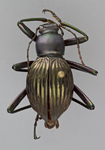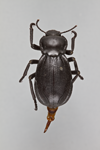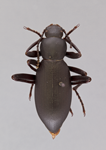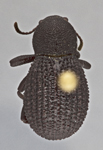 Darkling beetles (Coleoptera: Tenebrionidae), with approximately 20,000 described species, represent one of the great radiations of biodiversity in the world. They are present in nearly every terrestrial ecosystem due to the amazing array of forms, feeding habits, and life histories exhibited within the family. Some tenebrionid species, such as the red flour beetle, Tribolium castaneum (Herbst), and the yellow meal worm, Tenebrio molitor (Linnaeus), serve as model organisms for the study of evolution. However, the majority of tenebrionid species are still poorly know or awaiting description.
Darkling beetles (Coleoptera: Tenebrionidae), with approximately 20,000 described species, represent one of the great radiations of biodiversity in the world. They are present in nearly every terrestrial ecosystem due to the amazing array of forms, feeding habits, and life histories exhibited within the family. Some tenebrionid species, such as the red flour beetle, Tribolium castaneum (Herbst), and the yellow meal worm, Tenebrio molitor (Linnaeus), serve as model organisms for the study of evolution. However, the majority of tenebrionid species are still poorly know or awaiting description.
The overarching goal of this project is to disseminate information about tenebrionids to scientists and the public in order to aid in the identification of specimens, increase interest and understanding in the role darkling beetles play in the natural world, and facilitate the determination and description of new species. This is being accomplished by: 1. providing a repository for taxonomic names, identification keys, distributional and natural history data, images, literature, and phylogenetic hypotheses within the beetle family Tenebrionidae; and 2. producing an annotated glossary of tenebrionid morphological terms linked to the developing Coleoptera Anatomy Ontology (ColAO) project in order to provide explicit definitions and images for the anatomical terms used to describe and differentiate tenebrionid species.
Like taxonomy itself, tenebrioniDBase is a work in progress. Our two initial focal groups have been the genus Eleodes Eschscholtz and the tribe Asidini. Please check back for updates as information and keys are added for additional taxa. The individual subprojects within tenebrionDBase currently consist of over 900 unique images in over one thousand taxon pages. Over 7,400 references relating to the Tenebrionidae, with many linked to both associated taxon names and a pdf copy of the work (when available and not protected by copyright), have also been added to date.
This site is being actively developed by members of the Smith Insect Biodiversity Lab, in conjunction with our collaborators in the greater tenebrionid taxonomic community. Editing and development are done almost entirely using the mx bioinformatics platform (soon to be TaxonWorks). Please contact with comments, concerns, or corrections.





Cite this project: Smith, A.D. tenebioniDBase. http://tenebrionidbase.org. Accessed on Sat Apr 20 06:15:44 -0500 2024.

